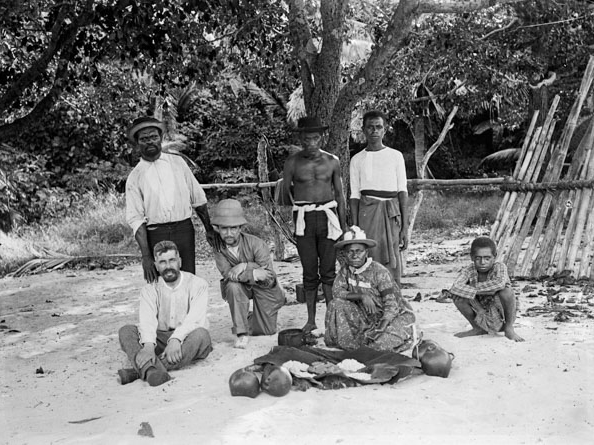Antia Herle
Torres Strait
Alfred Haddon is widely acknowledged as one of the key figures in the professionalization of British anthropology and the development of ethnographic fieldwork methodologies. His research drew on his own formation and activities in the natural sciences. A Cambridge-trained zoologist, he first went to the Torres Strait in 1888 to study marine biology and then returned as the leader of the 1898 Cambridge Anthropological Expedition (see also Recording Kastom: Alfred Haddon's Journals from the Torres Strait and New Guinea, 1888 and 1898). With the assistance of named Islanders, the Expedition generated an enormous amount of material (artefacts, zoological and botanical specimens, photographs, field notes, Indigenous drawings, kinship charts and sound recordings), most of which is cared for in Cambridge. This material and the extensive data published in the six volumes of the expedition’s reports (1901 – 1935) remain foundational for researchers from numerous disciplines working in the region. Crucially, this legacy is of great importance to many Torres Strait Islanders, who are productively mobilizing the knowledge embedded in these collections to better understand their past as well as to address pressing concerns related to land rights, cultural and environmental sustainability, and political self-determination.
Haddon’s work combined insights and methodologies from ethnology, archaeology, art, natural history and geology. Yet the collections in Cambridge are typically classified according to disciplinary interests, with the artefacts housed at the Museum of Archaeology & Anthropology (MAA), the biological specimens in the Zoology Museum, the plants in the Herbarium and the papers in the University Library. These types of distinctions – between academic disciplines, past and present, and nature and culture – do not have the same salience for many Torres Strait Islanders. Multifaceted objects reference environmental knowledge, genealogies, ritual practices and laws by which to live. In collaboration with Torres Strait Islanders, this project explores the co-constitution of ethnographic and natural history collections. It aims to evaluate and contribute to the far-reaching and continuing value of museum collections as repositories of cultural and environmental knowledge, for members of source communities and scholars.
For more information on the research initiative, visit the project page of Beyond the nature/culture divide.
 Large sculpture of a Torres Strait pigeon carved from coral. Collected by Haddon on Masig, Torres Strait, 1888. Dimensions: H 70 cm, L 35 cm, W 45 cm. Museum of Archaeology & Anthropology, University of Cambridge, Acc. No. Z 9787. Photo: MAA.
Large sculpture of a Torres Strait pigeon carved from coral. Collected by Haddon on Masig, Torres Strait, 1888. Dimensions: H 70 cm, L 35 cm, W 45 cm. Museum of Archaeology & Anthropology, University of Cambridge, Acc. No. Z 9787. Photo: MAA.
 Picnic on the beach at Dauar, Torres Strait, 14 May 1898. Haddon seated on the left with (l-r) Pasi, Ray, probably Koriba, Mrs Canoe, unknown youth, and Poi Pasi (squatting). Museum of Archaeology & Anthropology, University of Cambridge, Acc. No. N.23140.ACH2. Photo: MAA.
Picnic on the beach at Dauar, Torres Strait, 14 May 1898. Haddon seated on the left with (l-r) Pasi, Ray, probably Koriba, Mrs Canoe, unknown youth, and Poi Pasi (squatting). Museum of Archaeology & Anthropology, University of Cambridge, Acc. No. N.23140.ACH2. Photo: MAA.

